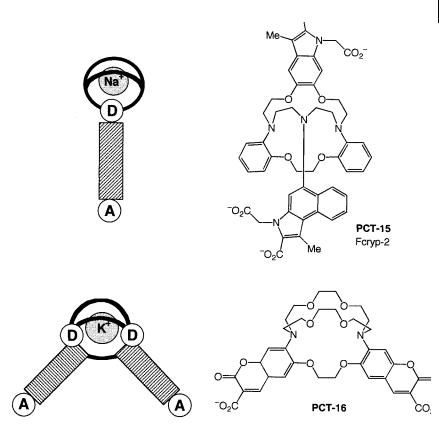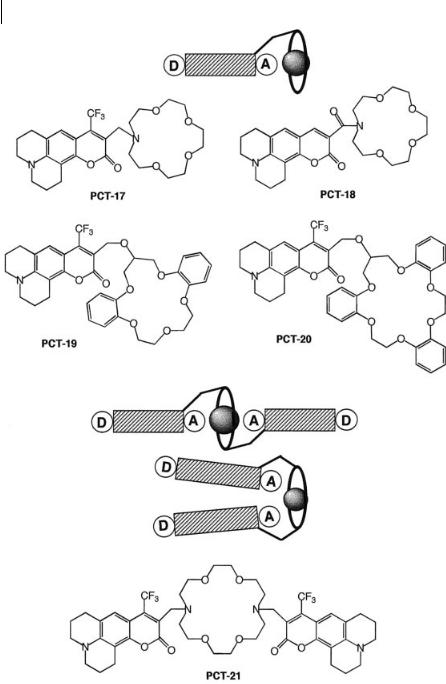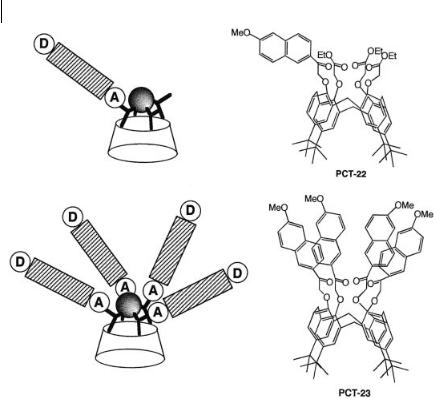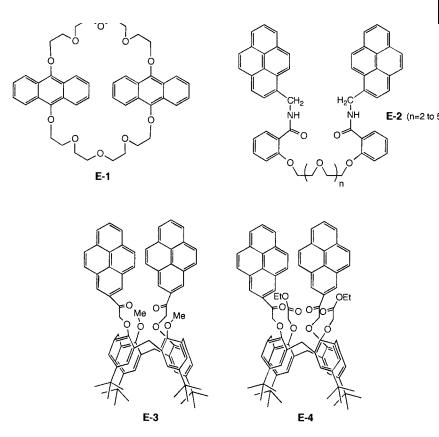
Molecular Fluorescence
.pdf
10.3 Fluorescent molecular sensors of cations 305
Fig. 10.23. Cryptand-based PCT sensors (PCT-15: Smith G. A. et al. (1988) Biochem. J. 250, 227. PCT-16: Grossley R. et al.
J.Chem. Soc. Perkin Trans. 2, 1615).
ˇ
Another example of a cryptand is PCT-16 (Figure 10.23), which has potential applications as an extracellular probe of potassium. The dissociation constant in water is 1 mmol dm 3, i.e. slightly lower than that of the coumarocryptand PET-5 (see Section 10.3.2).
10.3.3.3 PCT sensors in which the bound cation interacts with an electronwithdrawing group
In contrast to the above-described systems, there are only few systems in which the bound cation can interact with the acceptor part of charge-transfer probes. The case of coumarins linked to crowns (Figure 10.24) is of special interest because the cation interacts directly with the electron-withdrawing group, i.e. the carbonyl group, in spite of the spacer between the fluorophore and the crown. An important consequence is the increase in stability constant of the complexes with respect to the same crown without external complexing atoms.


10.3 Fluorescent molecular sensors of cations 307
Regarding the cation-induced photophysical changes, it should be kept in mind that the dipole moment of aminocoumarins in the excited state is larger than in the ground state because of the photoinduced charge transfer occurring from the nitrogen atom of the julolidyl ring to the carbonyl group. Therefore, when a cation is coordinated with the carbonyl group, the excited state is more stabilized than the ground state, so that both the absorption and emission spectra are red-shifted.
The selectivity of PCT-17 was in general found to be poor, because of the flexibility of the crown as well as around the spacer between the dye and the crown. Moreover, the nitrogen atom of the crown is easily protonable. The replacement of the methylene bridge of PCT-17 by an amide bridge in PCT-18 precludes pH sensitivity and leads to an improvement of the selectivity towards alkaline earth metal ions with respect to alkaline cations because the amide bridge is more rigid. Another way of improving the selectivity is to use a more rigid crown containing phenyl groups like dibenzocrown or tribenzocrown. This can be achieved by replacing monoaza-15-crown-5 by the more rigid dibenzocrown to give PCT-19. In acetonitrile, this system was found to be selective for some cations, i.e. the selectivity expressed as the ratio of the stability constants is 12 500 for Ca2þ/Mg2þ and 16 for Naþ/Kþ. The spectral shifts with cations are larger with PCT-19 compared to those observed with PCT-17 and PCT-18 and could be explained by the length of the bridge. We might expect that PCT-19 adopts a conformation where the bound cation is closer to the carbonyl group compared to the other systems.
A tribenzocrown has been covalently linked to coumarine to give PCT-20. This complexing moiety is expected to be selective for Kþ. The Kþ/Naþ selectivity is only 2 in acetonitrile, but 20 in ethanol.
These examples show that the most important parameters responsible for selectivity in these crowned coumarins are (i) the rigidity of the link beween the fluorophore and the crown, (ii) the rigidity of the crown itself, and (iii) the size of the crown.
Additional photophysical e ects can be observed when the fluoroionophore contains two fluorophores. In PCT-21 (Figure 10.24), the carbonyl groups of the two coumarin moieties participate in the complexes: direct interaction between these groups and the cation explains the high stability constants and the photophysical changes. In addition to the shifts of the absorption and emission spectra, an interesting specific increase in the fluorescence quantum yield upon binding of Kþ and Ba2þ ions has been observed: in the complexes with these ions that fit best into the crown cavity, the carbonyl groups of the two coumarins are preferentially on the opposite sides with respect to the cation and self-quenching is thus partially or totally suppressed, whereas with cations smaller than the cavity size of the crown, the preferred conformation of the relevant complexes may be such that the two carbonyls are on the same side and the close approach of the coumarin moieties accounts for static quenching.
Calixarene-based compounds PCT-22 and PCT-23 (Figure 10.25) containing one or four appended naphthalenic fluorophores, respectively, exhibit outstanding fluorescence enhancements upon cation binding and are very selective for Naþ (see Box 10.2).

308 10 Fluorescent molecular sensors of ions and molecules
Fig. 10.25. Calixarene-based PCT sensor in which the bound cation interacts with the acceptor group (PCT-22: Leray I. et al. (1999) Chem. Commun. 795. PCT-23: Leray I. et al., Chem. Eur. J. 7, 4590-8).
10.3.4
Excimer-based cation sensors
When a fluoroionophore contains two fluorophores whose mutual distance is affected by cation complexation, recognition of this cation can be monitored by the monomer/excimer fluorescence-intensity ratio (see Chapter 4, Section 4.4.1 for excimer formation). Cation binding may favor or hinder excimer formation. In any case, such a ratiometric method allowing self-calibration measurement is of great interest for practical applications.
The bisanthraceno-crown ether E-1 (Figure 10.26) exhibits a fluorescence spectrum composed of the characteristic monomer and excimer bands. Gradual addition of sodium perchlorate to a solution in methanol induces a decrease in the monomer band and an increase in the excimer band. Complexation is indeed expected to bring closer together the two anthracene units, which favors excimer formation. A 2:1 (metal:ligand) complex is formed with Naþ in methanol and acetonitrile with a positive cooperative e ect (see Appendix B). Interestingly, the overall stability constant obtained from absorption data was found to be lower than that






314 10 Fluorescent molecular sensors of ions and molecules
The Naþ sensor M-9 has a structure analogous to that of compound E-4, but instead of two identical pyrene fluorophores, it contains two di erent fluorophores with a pyrene group and an anthroyloxy group. Resonance energy transfer (see Chapter 9) from the former to the latter is then possible because of the spectral overlap between the fluorescence spectrum of the pyrene moiety and the absorption spectrum of the anthroyloxy moiety. Upon addition of Naþ to a solution of M-9 in a mixture of MeOH and THF (15:1 v/v), the fluorescence of the anthroyloxy group increases significantly compared with that of the pyrene group, which permits a ratiometric measurement.
An original fluoroionophore M-10, consisting of a conjugated poly(phenylene bithiophene) linked to calixarene, was designed and tested with various cations. An outstanding selectivity towards Naþ was observed, whereas Liþ, Kþ or Ca2þ induce negligible e ects. The blue-shift of the emission spectrum upon sodium binding appeared to be much more pronounced than with a monomeric model compound and no emissive point was observed. This interesting behavior may be due to migration of excitation energy to regions of the polymer that do not have bound Naþ and can relax to lower energy conformations.
10.3.6
Concluding remarks
The examples described above illustrate the immense variety of fluoroionophores that have been designed for cation recognition. Emphasis was put on the understanding of cation-induced photophysical changes, which should help the user and the designer of this kind of sensor.
A distinct advantage of PET sensors is the very large change in fluorescence intensity usually observed upon cation binding, so that the expressions ‘o –on’ and ‘on–o ’ fluorescent sensors are often used. Another characteristic is the absence of shift of the fluorescence or excitation spectra, which precludes the possibility of intensity-ratio measurements at two wavelengths. Furthermore, PET often arises from a tertiary amine whose pH sensitivity may a ect the response to cations.
In PCT sensors, the changes in fluorescence quantum yield on cation complexation are generally not very large compared to those observed with PET sensors. Nevertheless, exceptions can be found (see PCT-7 and PCT-22). However, the absorption and fluorescence spectra are shifted upon cation binding so that an appropriate choice of the excitation and observation wavelengths often allows us to observe quite large changes in fluorescence intensity. Moreover, ratiometric measurements are possible: the ratio of the fluorescence intensities at two appropriate emission or excitation wavelengths provides a measure of the cation concentration, which is independent of the probe concentration (provided that the ion is in excess) and is insensitive to the intensity of incident light, scattering, inner filter e ects and photobleaching. Ratiometric measurements are also possible with excimerbased sensors.
It should be emphasized that the selectivity and e ciency of binding towards a
